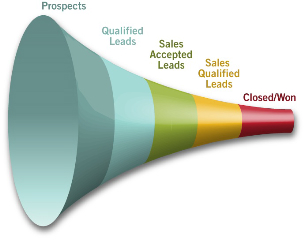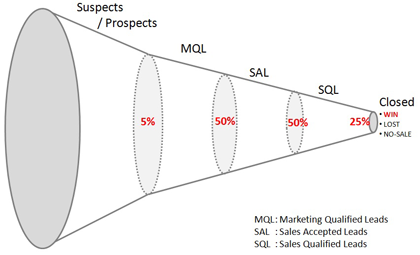
The management framework of B2B opportunities
To develop the best management practices of
opportunities, organizations can not rely solely on technology.
The head of B2B marketing must develop
a management framework towards opportunities.
1. Data - The foundation of your business's success
It should not be a secret that the success of any marketing campaign starts with good relational data. However, many companies are still struggling with the updating of their data.
Developing your data management process is the basis for the opportunities management framework. Even the best conceived campaigns can not overcome the obstacle of erroneous data. Companies looking to make a quick profit should immediately begin their work with this component.
To stay in control of their data, B2B organizations must focus on three key areas:
- The storage of databases
- Controlling databases and data integrity
- Profiling data
I- Storing databases
Many companies have a common practice of using a single internal database of customers and prospects. Typically, the CRM system (Customer Relationship Management) is viewed by two divisions, Sales and Marketing. That not only increases the chances of mistakes, but it also creates a risk for data security.
II-Controlling databases and their integrity
Up to 20% of the data goes bad every year, making the maintenance of data integrity one of the biggest challenges organizations face. Organizations with better data management have developed business rules to determine who will have access to data and how these will be controlled and monitored.
III- Profiling data
As B2B buyers continue to evolve and become more educated, impersonal mass communication becomes less effective. One to one dialogues with prospects and customers are more important than ever in a B2B context. To do this, organizations must create ideal customer profiles based on key criteria. These profiles become the foundation of all the campaigns and help to determine the segmentation strategy, messages and offers to use.

2. Planning opportunities (Quantity vs. Quality)
For a number of marketing departments, generating opportunities is an exercise in the dark: these departments do not know how many qualified leads they need to achieve sales targets.
When it comes to planning opportunities, marketing can hardly answer questions such as ...
- What percentage of quarterly revenue (in terms of opportunities) is responsible for sales results?
- How many sales opportunities do they need to achieve the objectives?
- How should one suspect interest globally in order to obtain the required number of qualified leads?
- What are the conversion rates? (Suspect to Client Qualified, Qualified Client to Sale)
A detailed planning process will enable organizations to answer these questions.
To develop this process, organizations need to know the following:
- The overall objective of sales (quarterly, annual, etc.) ;
- The percentage of the overall objective of sales to be allocated to marketing so that it can determine how many potential customers they have to generate;
- The average selling price (ASP), product or service;
- The conversion rate through the sales cycle. At a minimum, determine the conversion rate:
- Suspect to Prospect
- Prospect to a Marketing Qualified Lead (MQL)
- MQL to Sales Qualified Lead (SQL)
- SQL to a Sale
- If the total number of eligible customers is sufficient to achieve sales targets;
- The budget necessary to achieve sales targets;
- If the funnel of opportunities is sufficiently stocked (Suspect, Prospect, MQL, SQL, Application, etc ...).
Once the plan has developed opportunities, be sure to monitor them on a regular basis (monthly or quarterly) and make the necessary adjustments to ensure that the figures identified are in line with sales targets.
Developing the planning process can eliminate "I think" opportunities in regard to generating opportunities and enables organizations to achieve greater control over the measures of the company.
3. Qualification opportunities
According to a study published by Marketing Sherpa, 52% of B2B companies argue that the generation of opportunities is their biggest challenge. One reason for this challenge is the lack of a definition of what constitutes an opportunity. Marketing defines what an opportunity does but it does not always correspond with the definition of Sales. Therefore, the opportunities provided by the Marketing are often ignored by the Sales and too often end up in a chain, a drawer or an unavailable mailbox.
Defining the steps of an opportunity
We must begin by creating a set of definitions of common opportunities that are understood and accepted by both Marketing and Sales. Definitions must be determined for each stage of the sales cycle (from identification of a potential customer to closing the sale).
Developing the definitions of opportunity is only the first step in the process. In addition, organizations also need to establish criteria for what constitutes a Marketing Qualified Lead (MQL), a Sales Accepted Lead (SAL) and a Qualified Sales Lead (SQL). Each definition has different criterias, which incorporate both behavioral and demographic data and customer profiles developed during the data phase.
The qualitative value of an opportunity
The qualitative value of an opportunity is simply assigning a numerical value to the criteria established opportunities. By setting a numerical value to the criteria of opportunities, organizations will be able to classify suspects / prospects and will therefore ensure that the opportunity with the highest score is sent to Sales. Other opportunities that do not reach the MQL value should be separately manage until they reach that value and are ready to be sent to Sales.
To assign a qualitative value to an opportunity, you must assign a score based on a BANT criteria (Budget allocation, the Authority or the role in decision making, Need / solution (Need), Time). The following criterias are used:
- your customer profile (according to information from your database)
- behavior or interactions with customers. The main components of the behavioral criteria include:
- campaigns answered by the client (identified interest);
- events he attends (website, trade show, etc.);
- the actions it performs (downloads, calls).
Companies that adopt this opportunity qualification process observe an increase in their rate of closing sales and synergy present between Marketing and Sales.
Identification of market segments (type of industry, individuals)
The B2B buying process has changed. We're not down to a single buyer, but rather a multitude of stakeholders who influence the buying decision. The identification of market segments will not only consider the various types of businesses but also different types of influencers for purchase. For example, some are researching information, others recommend, others make decisions, etc…

4. Assignment opportunities (Who should be involved?)
According to several recent studies, up to 80% of buyers are not ready to buy when they respond to a marketing campaign. Therefore, the best companies must develop a process enabling multiple possibilities of assignments.
Type of assignment
The assignment of opportunities is probably one of the most neglected process in the overall opportunities management framework. The assignment of opportunities can be defined as the documented process that determines how qualified leads will be sent to sales. For example, what campaign relations will be initiated or how to redirect Marketing or Sales customers who delayed their project so that it can re-qualify potential customers in the future.
1. Marketing to Sales
2. Marketing campaign of customer relationship
3. Sales to Marketing to initiate the campaign customer relationship
Rules of management
Documenting your assignment process is a good start. However, if the process works, Sales and Marketing must jointly define and document the rules of opportunities management (SLA = Service Level Agreement).
The rules of management are agreements between Sales and Marketing that define how the assignment of opportunities works. SLAs are periods of time assigned to the rules of management.
The rules of management and SLAs should be developed for each of the three assignments mentioned above, as well as others that may be developed in the future.
Organizations that are serious about the implementation of a management framework of opportunity don't neglect this component of the process. It is too large to ignore and is often a key component that allows other processes to reach their full potential.

5. The opportunities incubator - the key to accelerate your sales cycle
Research has shown that up to 80% of prospects are not ready to buy the first time they interact with a company. This gives the opportunities incubator a key role in the opportunities management framework.
In addition, the following benefits are substantial :
- Sales from customer relationship campaigns are 47% higher than those closed without a customer relations campaign.
- The rate of opening emails from customer relations campaigns is 2x higher than from the opening of emails randomly.
- Companies improve their sales closure rate up to 20% when combined with customer relations campaigns.
While most prospects are not ready to buy at first contact, they will most likely be able to buy your product or service in the near future, whether it is your company or your competitor! The best thing an organization can do is to build a meaningful and long term customer relationship.
Follow the opportunities at each stage of the sales cycle
The objective of the incubator of opportunity is to build a one-to-1 connection with each potential customer. It is important to keep conversations through all stages of the sales cycle.
The opportunity incubator will not only improve your lead conversion rates and sales, but it will also improve your customer relationship AFTER a sale. Keeping a close connection with customers after the sale improves retention and customer loyalty in the long run for B2B companies.

6. Measurements and Analysis
A study by the "Sales Lead Management Association (SLMA)" showed that 64.9% of B2B organizations are unable to track the ROI of their marketing campaigns.
In addition to their inability to measure, companies struggle to determine what to measure and what they can expect from their indicators. As a result, companies are not getting the full potential of the indicators and measures.
The best companies understand that the value of marketing measures is an integral part of the opportunities management process. Companies wishing to implement the measurement process must begin by asking the following questions:
- What is the purpose of the campaign or activity?
- The demand generation?
- The Branding?
- The Knowledge?
- What should be measured to observe the success or failure of the campaign or event?
- In what way will the measure be captured?
- What is the analysis to be done?
- How will business intelligence derived from the measurements be used to plan ahead and be a reference for the past?
Asking these questions before starting any new activity or campaign will develop a roadmap that will ensure that the correct components are measured, eliminating the "I think ..." marketing process.
It is necessary to understand why, what, where and how measurements will allow your organization to improve in all aspects of marketing.
The right steps tell the history of the company and helps it to avoid the mistakes of the past, showing what works and what does not. B2B companies who understand this approach to marketing measures and make it an integral part of their management opportunities process, will see a marked improvement in their ROI on their marketing and sales.


 1. DataDeveloping your data management process is the basis of the GO framework.
1. DataDeveloping your data management process is the basis of the GO framework. 2. Planning opportunities Generating opportunities should not be an exercise in the dark.
2. Planning opportunities Generating opportunities should not be an exercise in the dark. 3. Qualification opportunitiesMarketing and sales are rarely the same definition of an opportunity.
3. Qualification opportunitiesMarketing and sales are rarely the same definition of an opportunity. 4. Assignment opportunitiesMarketing or Sales? Who will support the client and when?
4. Assignment opportunitiesMarketing or Sales? Who will support the client and when? 5. Incubator opportunities80% of customers are not willing to buy at the first visit ... But 60% will be in the near future.
5. Incubator opportunities80% of customers are not willing to buy at the first visit ... But 60% will be in the near future. 6. Measurements and Analysis60% of companies are unable to measure their ROI from their marketing campaigns.
6. Measurements and Analysis60% of companies are unable to measure their ROI from their marketing campaigns.